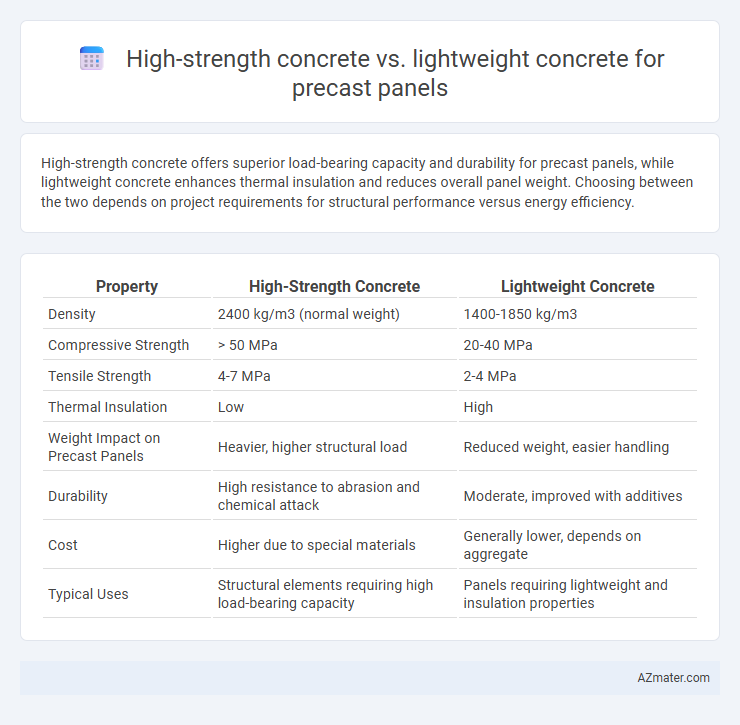High-strength concrete offers superior load-bearing capacity and durability for precast panels, while lightweight concrete enhances thermal insulation and reduces overall panel weight. Choosing between the two depends on project requirements for structural performance versus energy efficiency.
Table of Comparison
| Property | High-Strength Concrete | Lightweight Concrete |
|---|---|---|
| Density | 2400 kg/m3 (normal weight) | 1400-1850 kg/m3 |
| Compressive Strength | > 50 MPa | 20-40 MPa |
| Tensile Strength | 4-7 MPa | 2-4 MPa |
| Thermal Insulation | Low | High |
| Weight Impact on Precast Panels | Heavier, higher structural load | Reduced weight, easier handling |
| Durability | High resistance to abrasion and chemical attack | Moderate, improved with additives |
| Cost | Higher due to special materials | Generally lower, depends on aggregate |
| Typical Uses | Structural elements requiring high load-bearing capacity | Panels requiring lightweight and insulation properties |
Introduction to Precast Concrete Panels
Precast concrete panels utilize high-strength concrete to achieve enhanced structural performance, allowing for thinner, more durable panels that withstand heavy loads and resist environmental stress. Lightweight concrete in precast panels reduces overall panel weight, improving handling, transportation, and installation efficiency while providing better thermal insulation. Selecting between high-strength and lightweight concrete depends on project requirements such as load capacity, durability, and energy efficiency in precast panel applications.
Overview of High-Strength Concrete
High-strength concrete (HSC) for precast panels is characterized by its compressive strength typically exceeding 6,000 psi (41 MPa), providing enhanced load-bearing capacity and durability compared to conventional concrete. Its dense microstructure reduces permeability, resulting in improved resistance to environmental exposure, chemical attacks, and abrasion, making it ideal for demanding structural applications. The use of supplementary cementitious materials like silica fume and optimized aggregate gradation contributes to HSC's superior mechanical properties and long-term performance in precast construction.
Key Properties of Lightweight Concrete
Lightweight concrete used in precast panels offers reduced density ranging from 1,400 to 1,900 kg/m3, significantly lowering structural load compared to traditional high-strength concrete which typically exceeds 2,400 kg/m3. Its thermal insulation properties with conductivity values as low as 0.1-0.3 W/m*K enhance energy efficiency in building envelopes. Additionally, lightweight concrete exhibits improved fire resistance and adequate compressive strength, often between 17 to 35 MPa, making it suitable for both structural and non-structural precast applications.
Structural Performance Comparison
High-strength concrete offers superior compressive strength, typically exceeding 50 MPa, making it ideal for precast panels requiring high load-bearing capacity and durability in structural applications. Lightweight concrete, with a density of 1600-1920 kg/m3, provides reduced self-weight, enhancing seismic performance and ease of handling but generally has lower compressive strength between 20-40 MPa compared to high-strength variants. The choice between high-strength and lightweight concrete for precast panels ultimately hinges on the balance between structural requirements, weight constraints, and insulation needs, with high-strength concrete excelling in load capacity and lightweight concrete benefiting dynamic load resilience.
Durability and Longevity Factors
High-strength concrete for precast panels offers superior durability due to its low permeability and high compressive strength, significantly resisting environmental degradation and chemical attack. Lightweight concrete, while enhancing thermal insulation and reducing structural load, typically has higher porosity that can compromise long-term durability unless specially treated or coated. Selecting the appropriate concrete type depends on balancing the precast panel's structural demands with environmental exposure and maintenance expectations to maximize longevity.
Thermal and Acoustic Insulation Benefits
High-strength concrete precast panels provide exceptional structural durability but typically offer lower thermal and acoustic insulation compared to lightweight concrete. Lightweight concrete panels, made with materials like expanded clay or shale, enhance thermal resistance with reduced thermal conductivity and improve sound absorption due to their porous structure. Selecting lightweight concrete for precast panels optimizes energy efficiency and noise mitigation in building envelopes.
Installation and Handling Considerations
High-strength concrete in precast panels offers superior load-bearing capacity and durability but requires careful handling due to its increased density, necessitating robust lifting equipment and precise installation techniques to prevent damage. Lightweight concrete provides easier maneuverability and reduced structural load during installation, enhancing efficiency on-site, though it may require additional bracing to ensure stability due to its lower compressive strength. Both materials demand tailored installation procedures to optimize safety and performance, with high-strength panels benefiting from reinforced mechanical supports and lightweight panels requiring careful alignment to accommodate their flexibility.
Cost Implications and Economic Analysis
High-strength concrete offers superior load-bearing capacity and durability, which reduces long-term maintenance costs in precast panel applications despite higher initial material expenses. Lightweight concrete lowers transportation and installation costs due to its reduced density, improving overall project economics, especially in large-scale construction. Economic analysis must balance upfront material costs against lifecycle benefits, considering project scale and performance requirements for optimal cost-efficiency.
Environmental Impact and Sustainability
High-strength concrete for precast panels offers superior durability and load-bearing capacity but typically requires higher cement content, leading to increased CO2 emissions during production. Lightweight concrete reduces structural weight and enhances thermal insulation, contributing to lower energy consumption in buildings and often incorporates recycled materials, boosting sustainability. Selecting lightweight concrete can significantly decrease the carbon footprint of precast panels while maintaining adequate strength for many construction applications.
Choosing the Right Concrete for Precast Panels
High-strength concrete offers superior compressive strength and durability, making it ideal for load-bearing precast panels that require enhanced structural performance. Lightweight concrete reduces the overall panel weight, improving handling, transportation, and installation efficiency while providing adequate insulation and fire resistance. Selecting the right concrete depends on project requirements such as load capacity, thermal performance, and cost-effectiveness, with high-strength concrete suited for heavy-duty applications and lightweight concrete preferred when minimizing panel weight is critical.

Infographic: High-strength concrete vs Lightweight concrete for Precast panel
 azmater.com
azmater.com